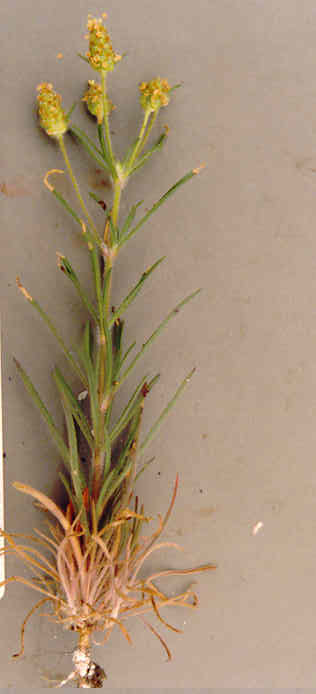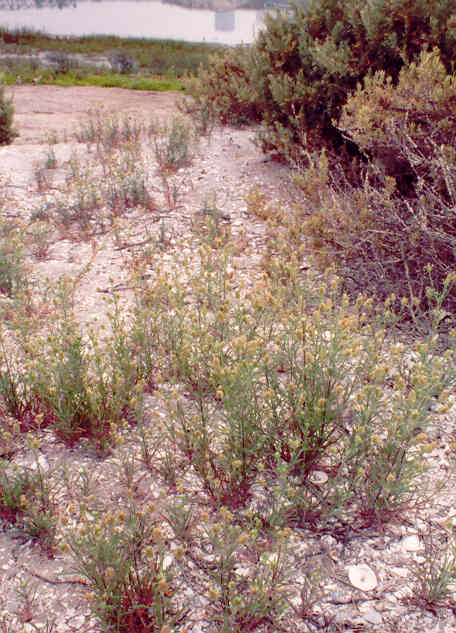
Plantago indica L.
=Plantago arenaria
 |
Plantago indica L.=Plantago arenaria
Plantaginaceae (Plantain Family)EurasiaSand Plantain |
June Photo
Plant Characteristics:
Caulescent, pubescent and somewhat glandular annual with simple or much-branched
leafy stems 8-40 cm. high; lvs. opposite, sometimes with shorter axillary lvs.,
sessile, hirsute or hirsute-villous, linear or linear-lanceolate, 6-8 cm. long,
2-4 mm. wide; infl. on axillary peduncles from the leaf-axils or umbellate at
the apex of the stems, the heads oval or subglobose; lowest bracts ovate,
abruptly long-acuminate, concave, 4-5 mm. long, the upper ovate or oval;
calyx-lobes obovate, hyaline-margined; corolla-lobes narrowly ovate, 2 mm. long,
acute, shorter than the tube; seeds 2, about 2.5 mm. long, reddish brown,
concave on the inner face.
Habitat:
Reported from sandy and waste places; it is often used as a constituent
of commercial bird-seed, poultry-feed, etc. and escapes.
July-Nov. (Munz, Flora
So. Calif. 635).
Name:
Latin, from planta, footprint.
(Munz, Flora So. Calif. 633).
Latin, aren, sand, a sandy
place. (Jaeger 25). Latin, arena or
harena, sand. (Simpson 56, 272). Latin,
indicus, of India
(Jaeger 127).
General:
Rare in the study area, having been found only on Northstar Beach where
there is a colony. In 2006, I noted that
the colony has expanded and now the species is found in all the the sandy area
northerly of the water channel and could be considered very common in the one
location. (my comment).
The seeds have a mucilaginous coat, hence are of some use as a
laxative. (Munz, Flora So. Calif. 633).
There are but 3 genera in the family, the principal one being Plantago,
in which occurs a majority of the species.
There are 14 species of Plantago
in California, 6 of which are introduced, the remainder native.
All are low herbs with flowers on long stems and leaves all basal.
(Robbins et al. 406). The
exception to the leaves being all basal is P.
indica. (my comment). Often used for bird seed and
poultry feed. (Hickman, Ed. 821).
Text Ref:
Abrams, Vol. IV 22; Hickman, Ed. 821; Munz, Flora
So. Calif. 635; Roberts 32.
Photo Ref:
May-July 92 # 18,19,20.
Identity: by R. De Ruff, confirmed by John Johnson.
Computer Ref: Plant Data 437.
Have plant specimen.
Last edit 6/1/06.
.
 |
June Photo